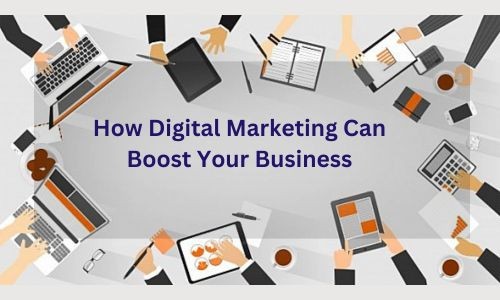
In today’s fast-paced and tech-driven world, the way businesses reach and engage with their audience has completely transformed. Traditional marketing methods like print ads, billboards, and TV commercials are no longer enough to keep up with changing consumer behavior. This is where digital marketing steps in — offering businesses of all sizes a powerful way to grow, compete, and thrive in the online marketplace.
Whether you’re a startup, small business, or an established brand, embracing digital marketing is no longer optional — it’s essential. Here’s how you can boost your business with digital marketing.
1. Build a Strong Online Presence
The first step in digital marketing is to create visibility. If people can’t find your business online, they won’t buy from you. Start by:
Creating a professional, mobile-friendly website.
Setting up a Google Business Profile for local visibility.
Being active on relevant social media platforms like Facebook, Instagram, LinkedIn, or Twitter depending on your niche.
A well-structured online presence increases credibility and gives customers a place to learn about your products or services, make purchases, or contact you directly.
2. Target the Right Audience
One of the greatest advantages of digital marketing is targeting. Traditional ads reach a wide audience, hoping your ideal customer is among them. But digital tools allow you to target by:
Demographics (age, gender, location)
Interests (hobbies, likes)
Behavior (online shopping habits)
Keywords (what they search online)
Platforms like Google Ads and Facebook Ads allow laser-focused targeting, which means your marketing budget is spent wisely and results are easier to measure.
3. Use SEO to Get Organic Traffic
Search Engine Optimization (SEO) helps your website rank higher on Google. When people search for products or services you offer, you want your site to show up on the first page.
Tips to improve your SEO:
Use relevant keywords on your website and blog.
Optimize meta titles, descriptions, and URLs.
Publish high-quality, helpful content regularly.
Improve website speed and make it mobile-friendly.
SEO is a long-term investment but brings high returns by driving free, consistent traffic to your site.
4. Engage Through Social Media Marketing
Social media isn’t just for selfies and memes — it’s a powerful business tool. It allows you to build relationships with your audience, promote offers, and get real-time feedback.
How social media helps your business:
Increases brand awareness
Encourages word-of-mouth marketing
Drives website traffic and leads
Provides customer service and support
Create a content calendar and post a mix of content: product highlights, behind-the-scenes, customer testimonials, educational posts, and promotional offers.
5. Create Valuable Content (Content Marketing)
Content marketing is about providing useful, relevant, and engaging information to your audience. This could be in the form of:
Blog posts
Infographics
Ebooks
Videos
Podcasts
This builds trust, educates your audience, and positions you as an authority in your industry. A business that educates sells better than one that only advertises.
6. Run Paid Ad Campaigns (PPC)
Pay-per-click advertising helps you reach customers faster. Platforms like Google Ads, Facebook, and Instagram allow you to show your ads to people who are actively searching for or interested in your products.
Benefits of PPC:
Instant visibility
Full control over budget and audience
Measurable performance
High ROI when done correctly
Even a small budget, if targeted well, can bring in good results and conversions.
7. Use Email Marketing to Stay Connected
Email marketing remains one of the most cost-effective channels. It allows you to stay connected with past, current, and potential customers.
Ways to use email marketing:
Send newsletters with updates and offers
Share new blog posts or product launches
Run personalized campaigns based on customer behavior
Use tools like Mailchimp, ConvertKit, or Constant Contact to design and automate your campaigns.
8. Analyze and Improve Continuously
One of the biggest advantages of digital marketing is data. Unlike traditional marketing, you can see what’s working and what’s not — in real time.
Track metrics like:
Website traffic (using Google Analytics)
Social media engagement
Email open and click rates
Ad conversions and cost-per-click
Based on data, make smart adjustments to your strategy to improve results over time.
9. Build Trust Through Online Reviews
Customer reviews and testimonials play a big role in purchasing decisions. Encourage satisfied customers to leave reviews on Google, Facebook, or product pages.
Respond to feedback, both positive and negative, professionally. A business that listens and improves builds lasting loyalty.
10. Stay Updated and Adapt
The digital marketing world evolves fast. Algorithms change, platforms rise and fall, and consumer behavior shifts. To stay ahead:
Keep learning through online courses or blogs.
Stay active in your industry community.
Be open to trying new tools and strategies.
A flexible business is a successful business.
Final Thoughts
Digital marketing isn’t just about being online — it’s about being visible to the right people, at the right time, with the right message. By combining the power of SEO, social media, paid ads, content creation, and analytics, you can not only boost your brand but also drive real business results — more leads, more sales, and more growth.
Whether you handle digital marketing yourself or hire an expert, taking action today can make a huge difference tomorrow.
Ready to grow your business digitally? Start small, stay consistent, and watch your brand thrive online.
